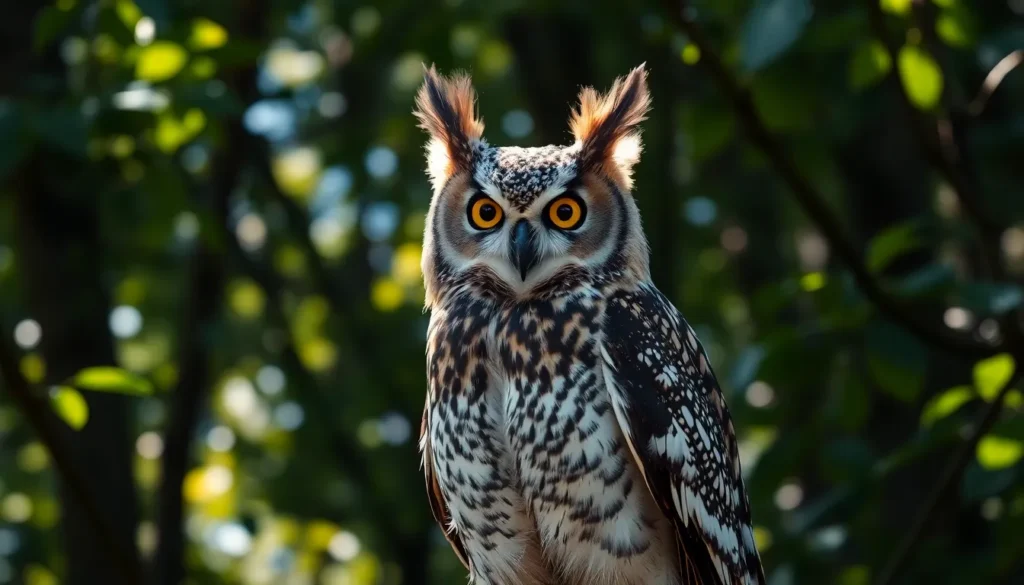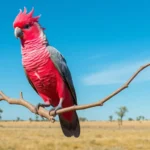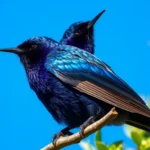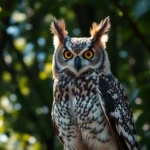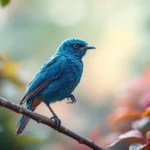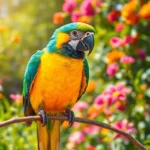We’ve all heard that haunting hoot echoing through the night, but owls represent far more than just mysterious woodland sounds. These remarkable birds of prey have captivated humans for millennia with their silent flight, piercing eyes, and incredible hunting abilities that make them nature’s most efficient nocturnal predators.
What makes owls truly extraordinary isn’t just their ability to rotate their heads 270 degrees or their asymmetrical ear placement that creates perfect acoustic maps of their surroundings. It’s how they’ve evolved into perfectly adapted killing machines that can snatch prey in complete darkness while remaining virtually silent.
From the massive Great Horned Owl to the tiny Elf Owl, we’re about to explore the intriguing area of these feathered hunters. You’ll discover why their unique adaptations make them so successful and learn surprising facts that’ll change how you think about these incredible creatures forever.
Physical Characteristics of Owl Birds
Owl birds possess remarkable anatomical features that distinguish them from other avian species. These specialized traits enable their exceptional nocturnal hunting abilities and make them among nature’s most efficient predators.
Distinctive Features and Anatomy
We observe several unique characteristics that define owl bird anatomy. Their large, forward-facing eyes occupy approximately 70% of their skull space and remain fixed in their sockets. This positioning creates exceptional binocular vision with depth perception that spans 110 degrees.
Facial discs made of specialized feathers surround each eye, functioning as acoustic reflectors that channel sound waves directly to their ears. These discs can be adjusted independently to optimize hearing accuracy. Asymmetrical ear placement, with one ear positioned higher than the other, allows owls to pinpoint prey location through triangulation of sound waves.
Flight feathers contain soft fringes along their edges that eliminate turbulence and create completely silent movement through air. The leading edge of their primary feathers features a comb-like structure called a fluttering fringe. Trailing edges possess flexible filaments that reduce air resistance.
Talons curve sharply and measure between 1-3 inches in length depending on species. Four toes per foot include a reversible outer toe that rotates to improve grip strength. Beak shape varies from short and curved for insect consumption to long and hooked for tearing mammalian prey.
Size Variations Across Species
Owl bird dimensions range dramatically across the 200+ species found worldwide. We’ve documented important variations that reflect their diverse ecological niches and prey preferences.
| Species | Height Range | Wingspan | Weight |
|---|---|---|---|
| Elf Owl | 4.9-5.7 inches | 10.5-11 inches | 1.4 ounces |
| Screech Owl | 6.3-9.8 inches | 18-24 inches | 3-8 ounces |
| Barn Owl | 12-15 inches | 31-37 inches | 14-25 ounces |
| Great Horned Owl | 17-25 inches | 36-60 inches | 2-5.5 pounds |
| Great Gray Owl | 24-33 inches | 54-60 inches | 1.5-3.7 pounds |
| Eurasian Eagle Owl | 23-28 inches | 55-71 inches | 3.3-9.25 pounds |
Larger species like the Eurasian Eagle Owl demonstrate powerful builds suited for capturing mammals weighing up to 37 pounds. Medium-sized owls such as the Barn Owl excel at hunting rodents and small birds. Smaller species including the Elf Owl specialize in insects and arthropods.
Body proportions remain consistent across sizes, with heads comprising 15-20% of total body length. Wing loading ratios stay between 0.5-0.8 grams per square centimeter, enabling efficient gliding and maneuvering through dense vegetation.
Different Species of Owl Birds
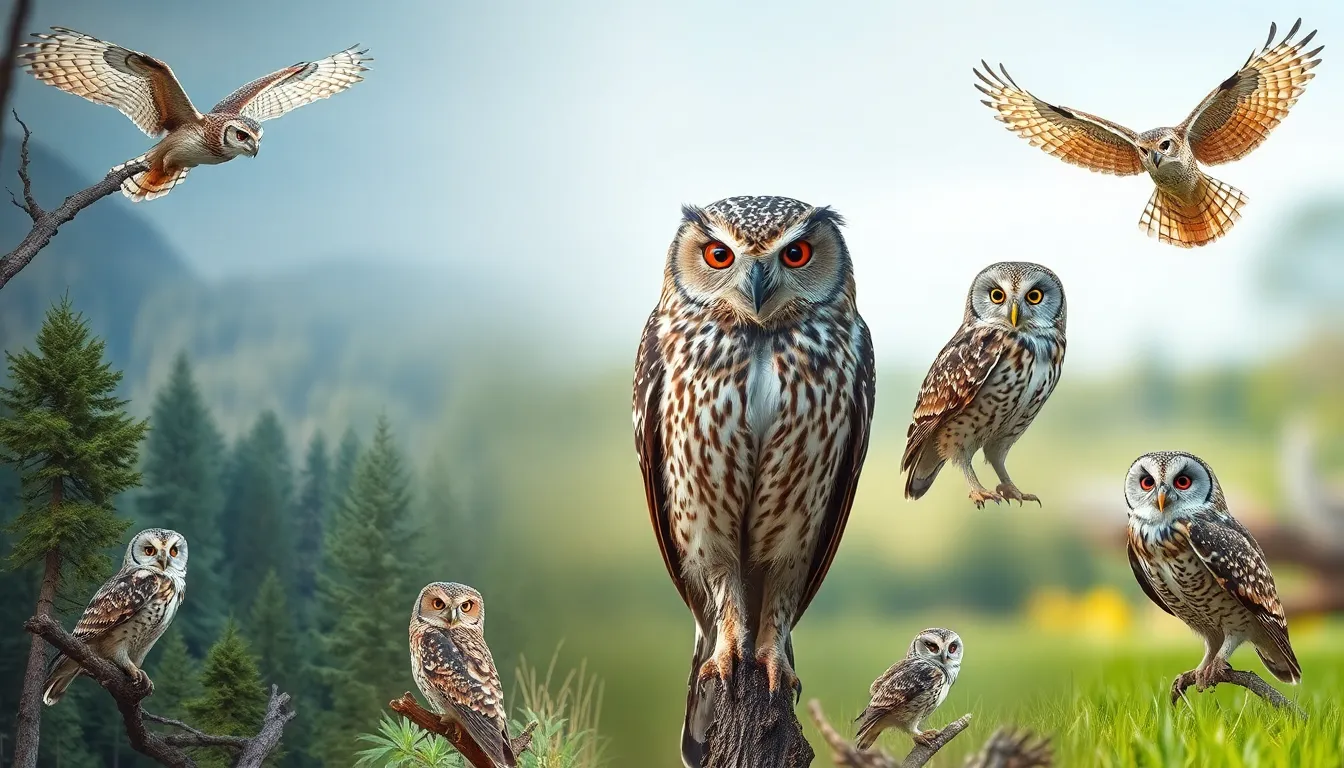
Over 200 owl species inhabit diverse ecosystems across the globe, each displaying unique adaptations for their exact environments. These nocturnal hunters range from common backyard residents to rare species found in remote wilderness areas.
Common North American Owls
Great Horned Owl (Bubo virginianus) stands as North America’s most widespread owl species, measuring 18-25 inches in height with wingspans reaching 60 inches. These powerful predators weigh 2-5.5 pounds and inhabit forests, deserts, wetlands, and urban areas from Alaska to South America.
Barn Owl (Tyto alba) displays distinctive heart-shaped facial discs and golden-buff plumage with white undersides. These medium-sized owls measure 12-16 inches tall with 42-inch wingspans, preferring open grasslands, farmlands, and abandoned buildings for nesting.
Eastern Screech Owl (Megascops asio) represents one of the smallest common owls in North America, standing only 6-10 inches tall. These compact hunters exhibit red and gray color morphs, allowing perfect camouflage against tree bark in deciduous and mixed forests.
Barred Owl (Strix varia) produces the famous “who-cooks-for-you” call that echoes through eastern North American forests. These stocky owls measure 16-25 inches in height and display distinctive brown and white barred plumage patterns across their bodies.
Northern Spotted Owl (Strix occidentalis caurina) inhabits old-growth forests of the Pacific Northwest, measuring 16-19 inches tall with chocolate-brown plumage marked by white spots. These medium-sized owls require large territories spanning 1,000-8,000 acres per breeding pair.
Rare and Exotic Owl Species
Blakiston’s Fish Owl (Bubo blakistoni) claims the title of industry’s largest owl species, with some individuals reaching 28 inches in height and weighing up to 10 pounds. These massive owls inhabit riparian forests of Russia, China, Japan, and North Korea, feeding primarily on fish and crustaceans.
Madagascar Red Owl (Tyto soumagnei) remains one of Africa’s rarest owl species, endemic to the eastern rainforests of Madagascar. These elusive owls display rusty-red plumage and measure approximately 11-13 inches in height, with fewer than 1,500 individuals estimated in the wild.
Forest Owlet (Heteroglaux blewitti) was considered extinct for 113 years until its rediscovery in central India in 1997. These small owls measure 6-7 inches tall and inhabit dry deciduous forests, with current populations estimated at fewer than 250 individuals.
Pel’s Fishing Owl (Scotopelia peli) represents Africa’s largest owl species, standing 20-25 inches tall with wingspans reaching 60 inches. These specialized hunters inhabit riverine forests across sub-Saharan Africa, using their unfeathered legs to catch fish from water surfaces.
Javan Owlet (Glaucidium castanopterum) exists only in the montane forests of Java, Indonesia, measuring just 6-7 inches in height. These critically endangered owls face severe habitat loss, with populations declining due to deforestation and agricultural expansion.
Habitat and Distribution
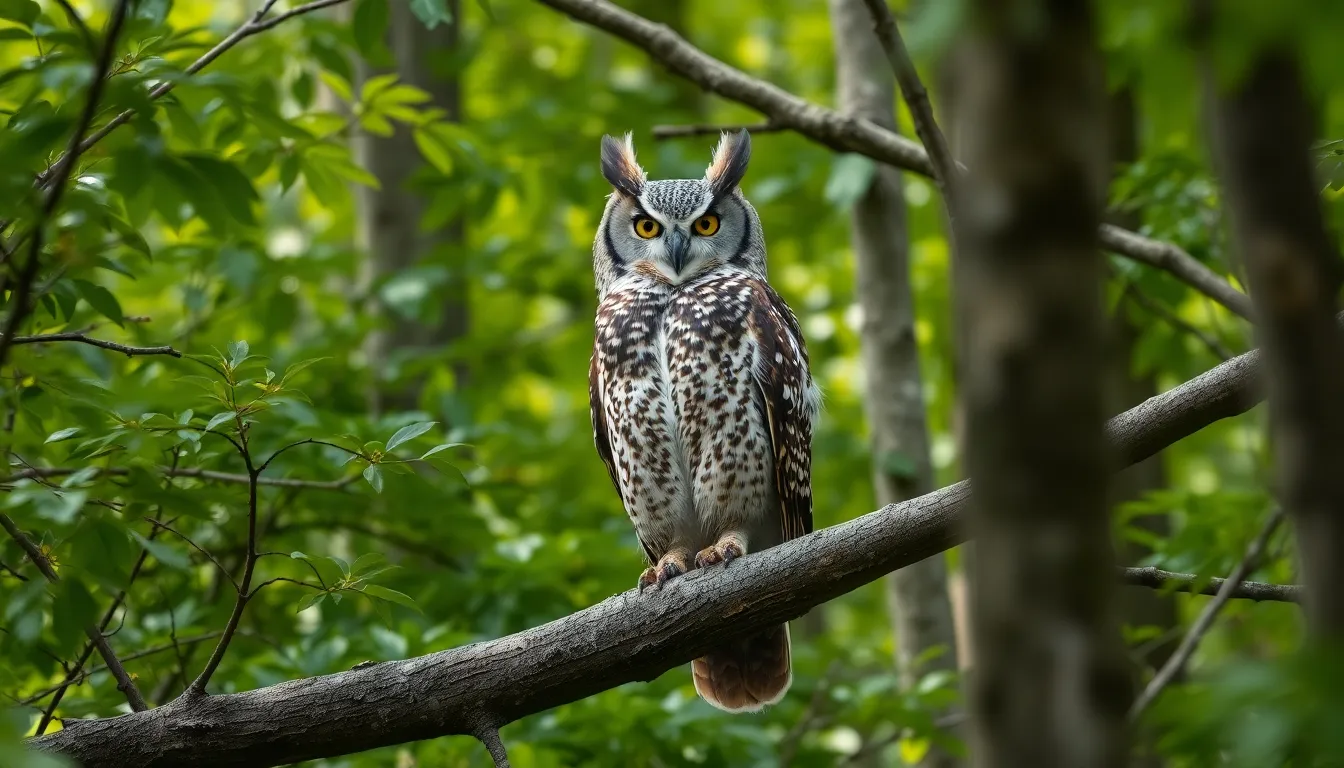
Owl species inhabit every continent except Antarctica and demonstrate remarkable adaptability across diverse ecosystems. These nocturnal hunters occupy environments ranging from dense tropical rainforests to arid deserts and urban landscapes.
Natural Environments Where Owls Thrive
Forest ecosystems support the highest concentration of owl species worldwide. Dense canopies provide optimal hunting grounds where Great Horned Owls and Barred Owls pursue small mammals and amphibians. Coniferous forests in northern regions house Boreal Owls and Great Gray Owls, which specialize in hunting voles beneath snow layers.
Grassland environments attract species like Burrowing Owls and Short-eared Owls. Open prairies offer clear sightlines for spotting rodents, while the absence of dense vegetation allows these ground-dwelling species to nest in abandoned burrows or ground scrapes.
Desert regions harbor specialized owl populations including Elf Owls and Western Screech Owls. These compact species exploit saguaro cacti and desert shrubs for nesting sites while hunting insects and small reptiles during cooler nighttime hours.
Urban areas increasingly support adaptable species such as Barn Owls and Eastern Screech Owls. City parks, abandoned buildings, and suburban neighborhoods provide sufficient prey populations of mice and rats, while structures offer suitable nesting cavities.
Wetland habitats sustain fishing specialists like Pel’s Fishing Owl in Africa and Blakiston’s Fish Owl in Asia. These environments combine shallow water fishing opportunities with adjacent trees for roosting and nesting.
Global Distribution Patterns
| Continent | Owl Species Count | Dominant Species |
|---|---|---|
| North America | 19 | Great Horned Owl, Barn Owl |
| South America | 35 | Tropical Screech Owl, Spectacled Owl |
| Europe | 13 | Tawny Owl, Eurasian Eagle Owl |
| Asia | 42 | Brown Fish Owl, Oriental Scops Owl |
| Africa | 31 | Pel’s Fishing Owl, African Scops Owl |
| Australia | 11 | Powerful Owl, Southern Boobook |
North American owl populations concentrate in temperate forests and grasslands from Alaska to Central America. The Great Horned Owl maintains the widest distribution across this continent, occupying habitats from sea level to 8,200 feet elevation.
European owl species cluster in deciduous and mixed forests, with the Tawny Owl dominating woodland areas from the British Isles to western Russia. Northern species like Snowy Owls migrate seasonally between Arctic breeding grounds and temperate wintering areas.
Asian owl diversity peaks in tropical Southeast Asia and the Himalayan foothills. Countries like Indonesia and Malaysia support over 15 endemic species each, including the critically endangered Forest Owlet and Javan Owlet.
African owl populations span from Mediterranean coastal regions to sub-Saharan savannas. The continent hosts unique fishing specialists and desert-adapted species that exploit seasonal water sources across the Sahel region.
Australian owl species evolved in isolation and occupy distinct ecological niches. The Powerful Owl represents the largest Australian species, while the diminutive Southern Boobook adapts to both forest and urban environments across the continent.
Hunting Behavior and Diet
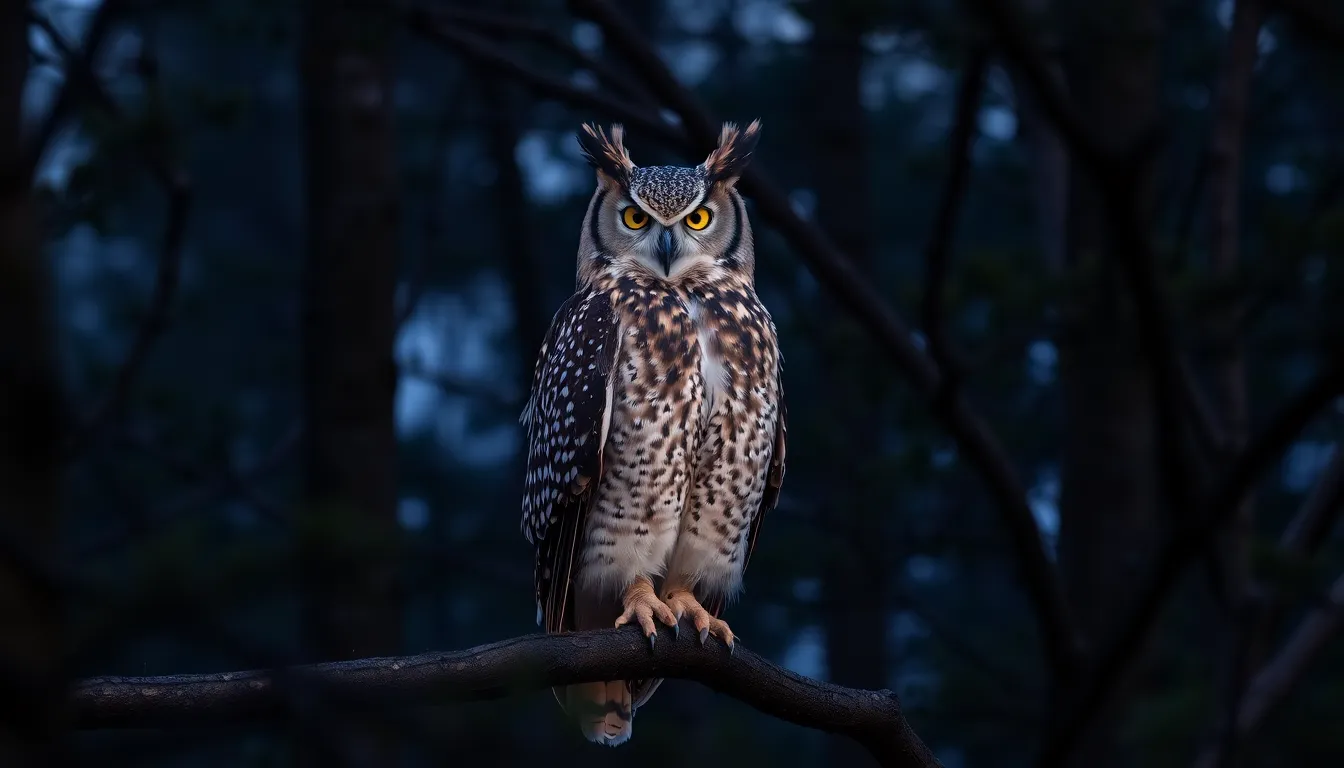
Owls employ sophisticated hunting strategies that capitalize on their specialized adaptations for darkness. These remarkable predators combine stealth precision with acute sensory capabilities to capture prey across diverse ecosystems.
Nocturnal Hunting Techniques
Silent flight forms the foundation of owl hunting success through specialized feather structures that eliminate sound production. Their primary flight feathers feature soft fringed edges that break up air turbulence while downy secondary feathers absorb remaining noise. This acoustic stealth allows owls to approach prey within striking distance without detection.
Asymmetrical ear placement gives owls three dimensional hearing capabilities that pinpoint prey locations with remarkable accuracy. The left ear opening sits higher than the right ear creating a time differential that helps owls calculate both horizontal and vertical prey positions. Great Horned Owls can detect mouse movements from distances exceeding 100 feet using this enhanced auditory system.
Facial disc feathers function as parabolic sound collectors that channel audio waves directly into their ear openings. Barn Owls possess the most pronounced facial discs among North American species enabling them to hunt in complete darkness. These feather arrangements can be adjusted like satellite dishes to focus on exact sound sources.
Head rotation capabilities reaching 270 degrees compensate for fixed eye positions while maintaining visual contact with potential targets. Owls accomplish this extreme mobility through 14 cervical vertebrae compared to 7 vertebrae in most mammals. This adaptation allows continuous prey monitoring without body movement that might alert victims.
Prey and Feeding Habits
Small mammals constitute the primary food source for most owl species with rodents representing 60-80% of their total diet consumption. Voles mice shrews and young rabbits provide the protein rich nutrition that sustains these active predators throughout their hunting seasons.
| Owl Species | Primary Prey | Secondary Prey | Hunting Success Rate |
|---|---|---|---|
| Great Horned Owl | Rabbits, skunks | Birds, fish | 75-85% |
| Barn Owl | Voles, mice | Shrews, bats | 80-90% |
| Screech Owl | Insects, mice | Small birds | 70-80% |
| Barred Owl | Fish, amphibians | Small mammals | 65-75% |
Fish eating specialists like Blakiston’s Fish Owl and Pel’s Fishing Owl demonstrate remarkable aquatic hunting adaptations including waterproof plumage and specialized talons. These species wade in shallow waters or perch above streams waiting for fish to surface within striking range.
Insectivorous species such as Elf Owls and Burrowing Owls consume beetles moths grasshoppers and other arthropods that provide essential nutrients during breeding seasons. Desert dwelling owls particularly rely on insect protein when mammalian prey becomes scarce during drought periods.
Hunting frequency varies significantly based on prey size and seasonal availability with smaller owl species requiring 2-3 successful captures daily. Larger owls like Great Horned Owls can survive on single large prey items for several days due to their efficient metabolic processes and food storage capabilities.
Unique Adaptations of Owl Birds
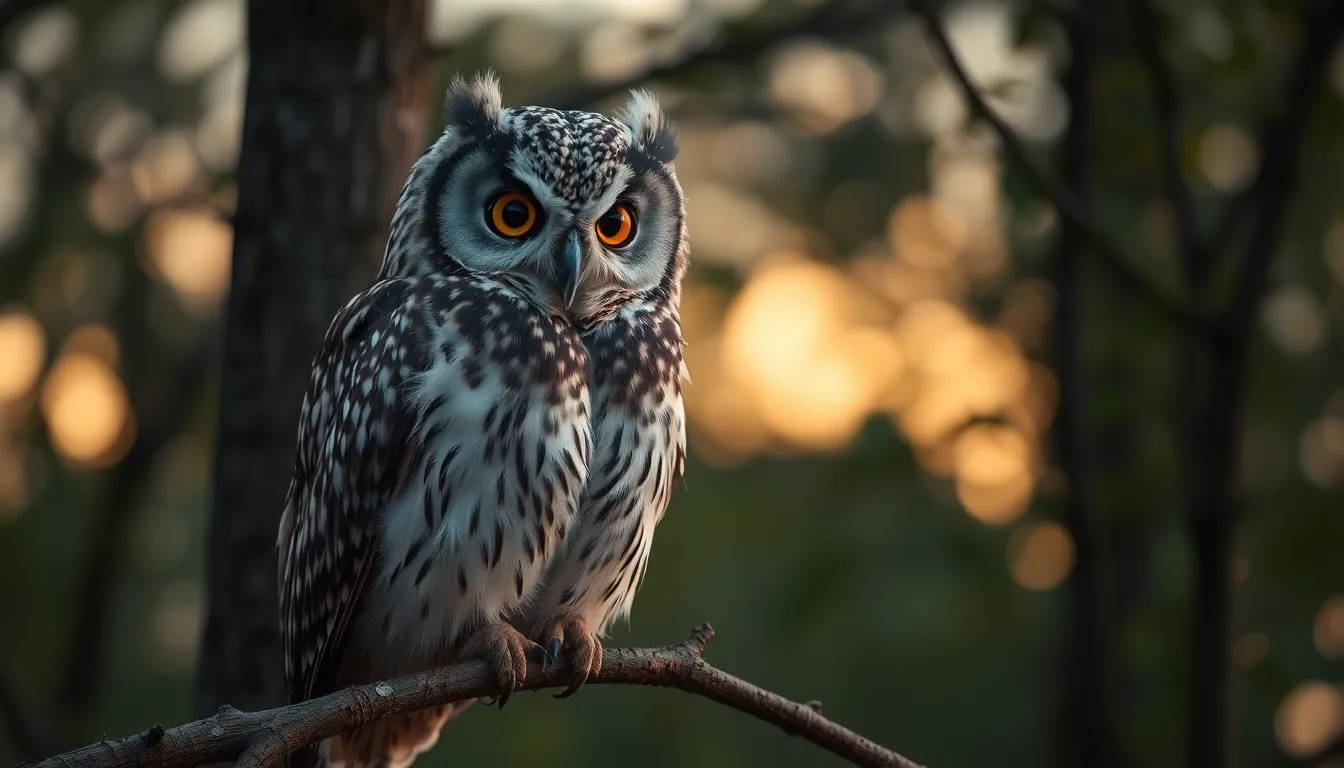
Owl birds possess extraordinary physiological adaptations that distinguish them from other avian predators. These specialized features enable owls to dominate their nocturnal hunting environments with unmatched efficiency.
Silent Flight Capabilities
Silent flight represents the most remarkable adaptation of owl birds, achieved through three distinct feather modifications. Serrated leading edges on primary flight feathers break up airflow turbulence, while soft fringes on trailing edges eliminate the vortices that create sound. Velvety down covers the entire wing surface, dampening any remaining noise during flight.
Large owl species like the Great Horned Owl demonstrate flight noise levels below 1.8 decibels, compared to 23 decibels produced by similarly sized hawks. Barn owls achieve even greater silence, with flight sounds measuring less than 0.6 decibels at distances of 6.5 feet. This acoustic stealth allows owls to approach prey within striking distance without detection.
Wing loading ratios in owls average 0.5 ounces per square inch, significantly lower than the 0.9 ounces per square inch found in hawks. Broader wing surfaces distribute body weight more effectively, reducing the air pressure required for flight. Flexible wing feathers adjust automatically to air currents, maintaining silent flight across varying wind conditions.
Exceptional Vision and Hearing
Owl bird eyes contain 5 times more rod cells than human eyes, enabling superior light sensitivity in darkness. Forward facing eye placement provides 70 degree binocular vision overlap, creating precise depth perception for accurate prey targeting. Tubular eye shapes maximize light gathering capacity, with corneas comprising 50% larger surface areas than comparable diurnal raptors.
| Vision Adaptation | Measurement | Comparison to Humans |
|---|---|---|
| Light sensitivity | 100x greater | Rod cell density |
| Binocular vision | 70 degrees | 120 degrees |
| Eye weight ratio | 5% of body weight | 1% of body weight |
Asymmetrical ear placement creates precise three dimensional hearing capabilities in owl birds. Right ear openings position higher than left ear openings, with vertical sound location determined by timing differences between ears. Facial disc feathers function as parabolic reflectors, channeling sound waves directly into ear openings with 10 decibel amplification.
Hearing frequency ranges in owls extend from 100 Hz to 12,000 Hz, encompassing all sounds produced by their primary prey species. Great Gray Owls detect mouse movements beneath 18 inches of snow using hearing alone. Barn owls pinpoint prey locations within 1.5 degrees of accuracy using acoustic triangulation, even in complete darkness.
Reproduction and Life Cycle
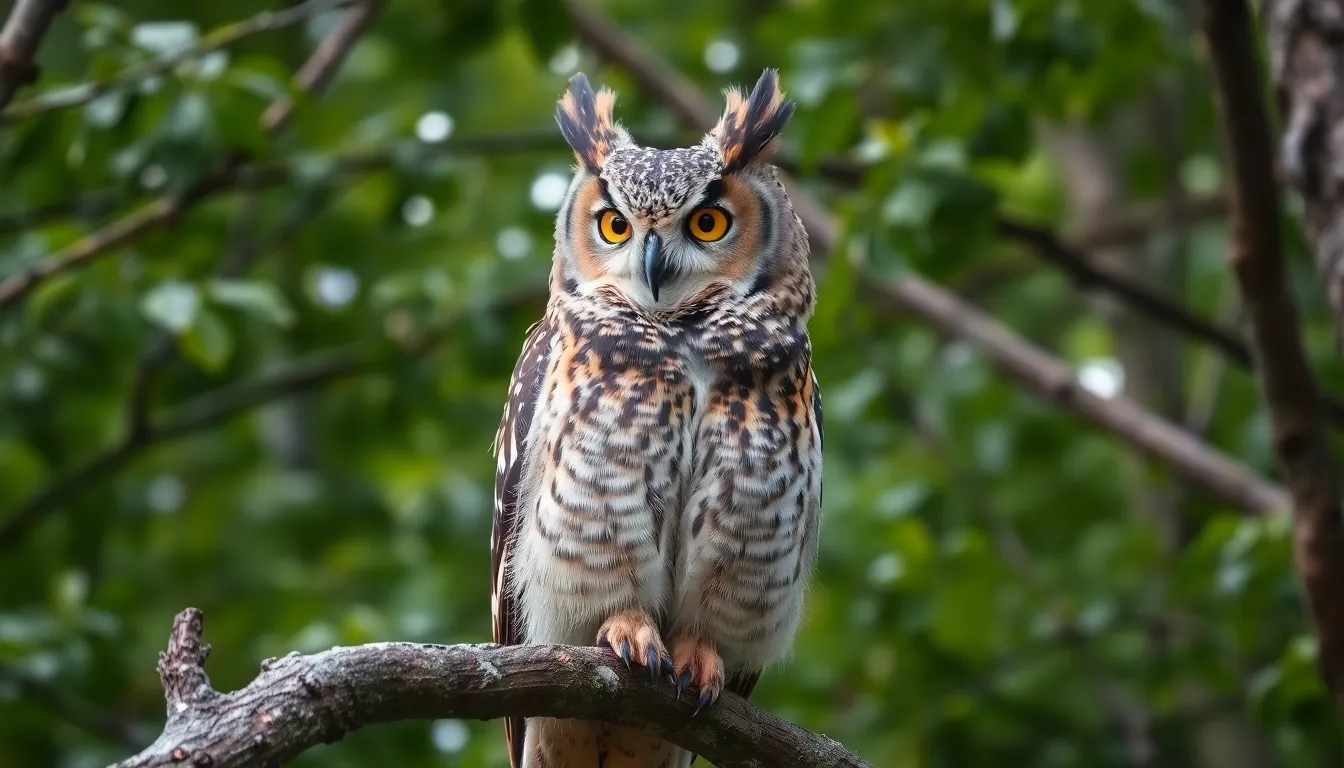
Owl reproduction follows distinct seasonal patterns that maximize survival rates for both parents and offspring. Most species begin their reproductive cycles during late winter or early spring when prey abundance peaks.
Mating Rituals and Nesting
Courtship behaviors in owls involve elaborate displays that strengthen pair bonds and establish territory ownership. Males perform aerial acrobatics while calling to attract females, with Great Horned Owls producing their distinctive “hoo-hoo-hoo” calls that can travel over 5 miles. Barn Owls execute figure-eight flight patterns accompanied by wing clapping sounds that create unique acoustic signatures.
Pair bonding occurs through mutual preening sessions and food sharing ceremonies where males present captured prey to potential mates. Established pairs often remain monogamous throughout breeding seasons, with some species like Barn Owls maintaining partnerships for multiple years.
Nesting site selection varies dramatically among species based on their ecological niches and body sizes. Tree cavity nesters like Eastern Screech Owls occupy hollows 10-30 feet above ground, while ground nesting Burrowing Owls excavate tunnels extending 6-10 feet underground. Barn Owls adapt to human structures, choosing barn lofts, church towers, and abandoned buildings as nesting locations.
| Nesting Preference | Species Examples | Typical Height | Clutch Size |
|---|---|---|---|
| Tree Cavities | Great Horned Owl, Barred Owl | 20-60 feet | 2-3 eggs |
| Ground Burrows | Burrowing Owl, Short-eared Owl | Ground level | 4-9 eggs |
| Human Structures | Barn Owl, Eastern Screech Owl | 10-40 feet | 3-7 eggs |
| Cliff Faces | Great Gray Owl, Snowy Owl | 15-50 feet | 3-5 eggs |
Egg laying typically occurs at 2-3 day intervals, creating age differences among siblings that affect survival rates. Incubation periods range from 26-35 days depending on species size, with females handling the majority of incubation duties while males provide food deliveries.
Caring for Young Owlets
Parental care begins immediately after hatching as owlets emerge covered in white down feathers and completely dependent on their parents. Newly hatched owlets weigh between 10-25 grams and cannot regulate their body temperature for the first 2-3 weeks of life.
Feeding schedules intensify dramatically once owlets hatch, with parent owls hunting continuously to meet the energy demands of growing chicks. Great Horned Owl parents deliver prey items every 2-3 hours during peak feeding periods, providing up to 8-12 prey items daily per brood. Barn Owl families consume approximately 3,000 rodents annually to support their reproductive efforts.
Development milestones occur at predictable intervals across owl species. Owlets open their eyes at 10-14 days old and begin developing their first flight feathers at 3-4 weeks. Branching behavior starts at 5-6 weeks when young owlets leave the nest but remain flightless, hopping between nearby branches while parents continue feeding them.
Fledging occurs at 6-10 weeks depending on species size, with smaller owls like Eastern Screech Owls achieving flight capabilities earlier than larger species like Great Horned Owls. Post-fledging dependency extends 2-4 months as parents teach hunting techniques and territorial boundaries to their offspring.
Survival rates vary significantly based on environmental conditions and prey availability. First-year mortality reaches 60-70% in most owl species, with starvation, predation, and vehicle strikes comprising the primary threats to juvenile owls. Successful juveniles that survive their first winter typically establish their own territories within 50-100 miles of their birth locations.
Cultural Significance and Symbolism
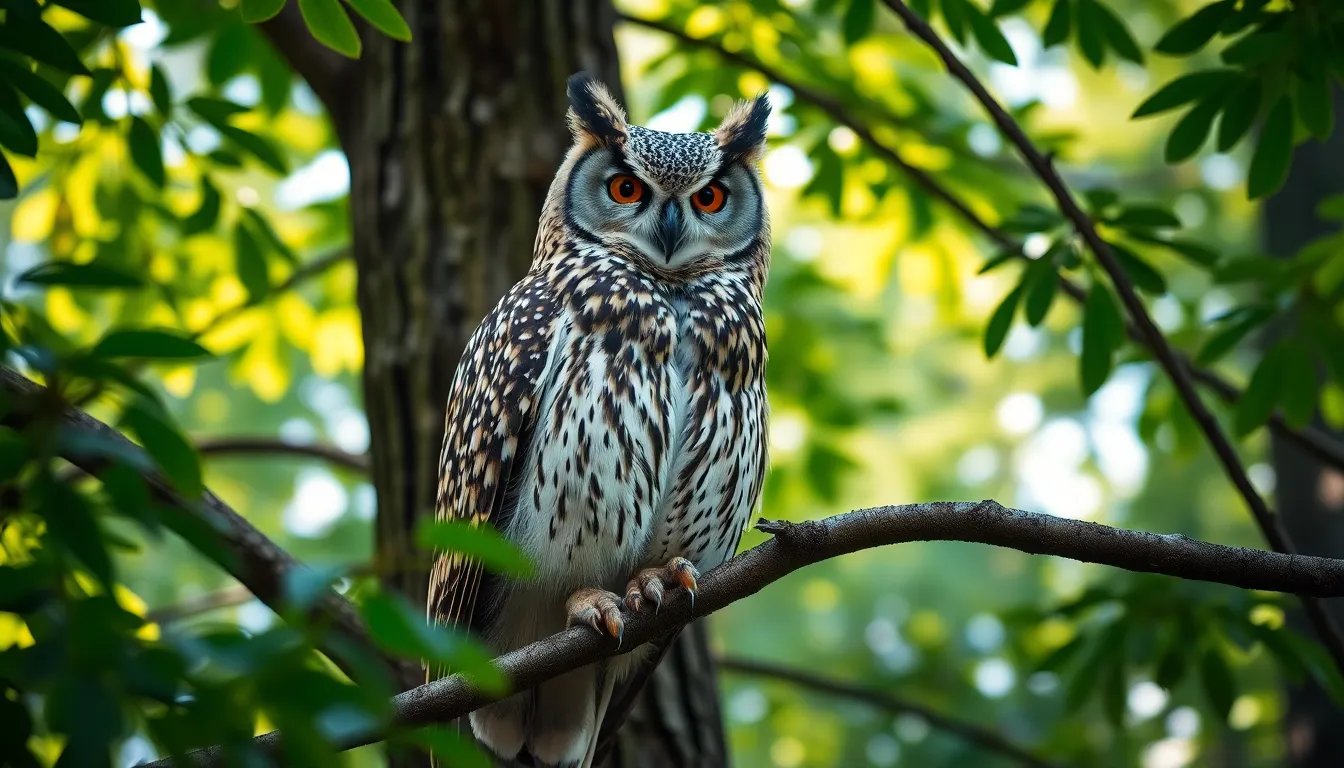
Owls occupy a unique position in human culture, serving as powerful symbols that transcend geographical and temporal boundaries. These nocturnal predators have shaped mythology, folklore, and conservation efforts across civilizations for thousands of years.
Owls in Mythology and Folklore
Ancient civilizations revered owls as symbols of wisdom and divine knowledge. Greek mythology features Athena, goddess of wisdom, with her sacred owl companion that could reveal hidden truths in darkness. Roman culture adopted this symbolism, minting coins depicting owls alongside Minerva, their equivalent deity of wisdom.
Native American tribes developed diverse owl symbolism reflecting their spiritual beliefs. Cherokee traditions view owls as protectors of sacred knowledge, while Lakota folklore associates owls with prophecy and supernatural insight. Apache culture considers owls as messengers between the living and spirit worlds, guiding souls during transitions.
European folklore presents contrasting owl symbolism across different regions. Celtic mythology portrays owls as guardians of the underworld, possessing ancient wisdom about life and death cycles. Medieval European culture often depicted owls as harbingers of doom or death, contrasting sharply with their positive representation in classical antiquity.
Asian cultures demonstrate equally complex owl symbolism. Hindu traditions associate owls with Lakshmi, goddess of wealth and prosperity, making owl sightings auspicious for financial success. Japanese folklore features the fukurou, owl spirits believed to bring good fortune and protection from suffering.
Modern literature continues this symbolic tradition, with authors like J.K. Rowling incorporating owls as magical messengers in the Harry Potter series. Contemporary symbolism often emphasizes owls’ connection to education, with their images appearing on academic institutions’ logos and educational materials worldwide.
Modern Conservation Efforts
Conservation organizations worldwide prioritize owl species protection through targeted habitat preservation programs. The Industry Wildlife Fund focuses on protecting old-growth forests essential for species like the Northern Spotted Owl, which requires mature forest ecosystems for successful breeding.
Breeding programs in captivity support critically endangered owl species recovery. The California Academy of Sciences operates successful breeding initiatives for Burrowing Owls, releasing over 200 individuals into restored habitats since 2010. These programs maintain genetic diversity while supporting wild population recovery.
Habitat restoration projects specifically address owl habitat requirements across diverse ecosystems. The National Audubon Society coordinates wetland restoration efforts benefiting Short-eared Owls, creating 15,000 acres of suitable grassland habitat in North America between 2015-2023.
Research initiatives provide crucial data for owl conservation strategies. Scientists use GPS tracking technology to monitor owl migration patterns, feeding behaviors, and territory requirements. This research informs protected area designation and corridor creation for owl movement.
Community engagement programs educate local populations about owl conservation importance. Organizations like the Owl Research Institute conduct citizen science projects, training volunteers to monitor owl populations and report nesting locations. These programs have documented over 3,000 owl nests across 12 states since 2018.
International cooperation addresses transboundary owl conservation challenges. The Migratory Species Convention coordinates protection efforts for species like the Short-eared Owl, which migrates across multiple countries requiring synchronized conservation policies.
Conclusion
Owls continue to captivate us with their extraordinary blend of mystery and remarkable biological engineering. These nocturnal hunters represent one of nature’s most successful evolutionary achievements combining silent flight exceptional vision and precise hearing into the perfect predatory package.
We’ve explored how these magnificent birds have adapted to virtually every habitat on Earth while maintaining their status as apex nocturnal predators. From the massive Blakiston’s Fish Owl to the tiny Elf Owl each species showcases unique answers to survival challenges.
Understanding owls deepens our appreciation for the delicate balance of ecosystems they help maintain. Their continued success depends on our commitment to preserving their habitats and supporting conservation efforts that protect these irreplaceable guardians of the night.
Frequently Asked Questions
What makes owls such effective nocturnal hunters?
Owls possess several specialized adaptations including silent flight feathers that minimize noise, asymmetrical ear placement for three-dimensional hearing, and eyes with five times more rod cells than humans for exceptional night vision. Their facial discs amplify sound, while their ability to rotate heads 270 degrees provides comprehensive awareness of their surroundings.
How many owl species exist worldwide?
There are over 200 owl species distributed across every continent except Antarctica. These species vary dramatically in size and habitat preferences, from the tiny Elf Owl weighing less than 1.5 ounces to the massive Eurasian Eagle Owl with wingspans exceeding 6 feet.
What do owls typically eat?
Owls are carnivorous predators with diets primarily consisting of small mammals, especially rodents like mice and voles. Depending on their size and habitat, they also hunt birds, insects, fish, amphibians, and reptiles. Larger species can capture rabbits and other substantial prey.
Where do owls typically nest?
Nesting preferences vary significantly among species. Many owls nest in tree cavities, while others prefer ground burrows, cliff faces, or abandoned buildings. Some species, like Barn Owls, commonly utilize human structures such as barns, church towers, and nest boxes.
How do owls achieve silent flight?
Owls have specialized feather modifications including soft, fringed flight feathers and downy surfaces that break up air turbulence. These adaptations reduce flight noise by up to 10 decibels compared to other raptors, allowing them to approach prey completely undetected.
What is the cultural significance of owls?
Owls have been symbols of wisdom in Greek and Roman cultures, associated with the goddess Athena. Different cultures attribute various meanings to owls, from protectors of sacred knowledge to messengers between worlds. They appear prominently in mythology, folklore, and modern literature worldwide.
How long do owls typically live?
Owl lifespans vary by species and environmental conditions. In the wild, most owls live 5-10 years, though larger species can live longer. Captive owls often live significantly longer due to veterinary care and consistent food supply, with some reaching 20-30 years.
Are owls endangered?
Conservation status varies among species. While many owl populations remain stable, several species face threats from habitat loss, climate change, and human encroachment. Notable endangered species include the Northern Spotted Owl and several tropical species with restricted ranges.

